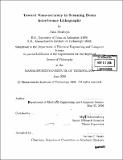Toward nano-accuracy in scanning beam interference lithography
Author(s)
Montoya, Juan, 1976-
DownloadFull printable version (17.02Mb)
Other Contributors
Massachusetts Institute of Technology. Dept. of Electrical Engineering and Computer Science.
Advisor
Mark Schattenburg.
Terms of use
Metadata
Show full item recordAbstract
Scanning beam interference lithography is a technique developed in our laboratory which uses interfering beams and a scanning stage to rapidly pattern gratings over large areas (300x300 mm2) with high precision. The repeatability of the system [approx.] ±3 nm is an important precursor for obtaining nanometer accuracy. The R&D award winning tool developed in our laboratory, referred to as the nanoruler, uses scanning beam interference lithography to pattern large gratings with periods on the order of 574 nm at velocities approaching 100 mm/s. In this thesis, I will present techniques which I developed to improve the accuracy of the nanoruler. These techniques include mirror mapping, which allows one to characterize the reference mirrors used for stage scanning. In addition, I will present characterization techniques which include translation and rotation tests to measure the distortion present in our system. In order to correct for the measured distortion, I have implemented an on the fly phase-lookup technique in which the phase of the interfering beams are modulated to correct for the system distortion. Several potential applications of this technology require not only high phase fidelity, but uniform linewidth as well. (cont.) Toward this end, I have presented a detailed analysis of the relationship between the exposure dose contrast, beam geometry, phase modulation, and stage scanning parameters. In addition, I have implemented novel scanning techniques which have allowed for patterning more general periodic structures. For example, a technique referred to as Doppler writing will allow one to scan the stage perpendicular to the interference fringes. This technique may be utilized to create several overlapping strips of grating, each with a different period, allowing one to obtain a chirp in a direction parallel to the interference fringes. Furthermore I developed a patterning technique referred to as beam-blanking. While conceptually simple, the challenges for implementing this writing strategy includes synchronization of high speed electronics with the stage motion to phase-lock the interfering beams to the stage at high stage velocities. By combining all of the latter techniques: namely the ability to phase-lock, turn off the writing beams, implement generalized scanning with phase-look up on the fly, several more generalized geometries of interest for applications including photonic Bragg devices, metrology, and X-Ray telescopes may be patterned at high speed, over large distances, with precision and accuracy.
Description
Thesis (Ph. D.)--Massachusetts Institute of Technology, Dept. of Electrical Engineering and Computer Science, 2006. Includes bibliographical references (p. 213-217).
Date issued
2006Department
Massachusetts Institute of Technology. Department of Electrical Engineering and Computer SciencePublisher
Massachusetts Institute of Technology
Keywords
Electrical Engineering and Computer Science.